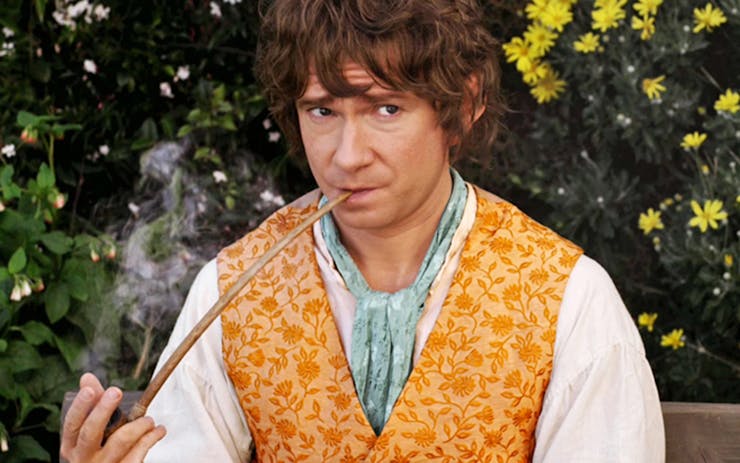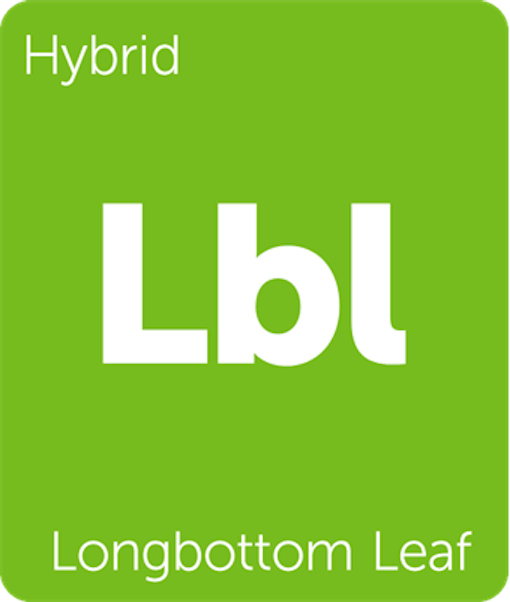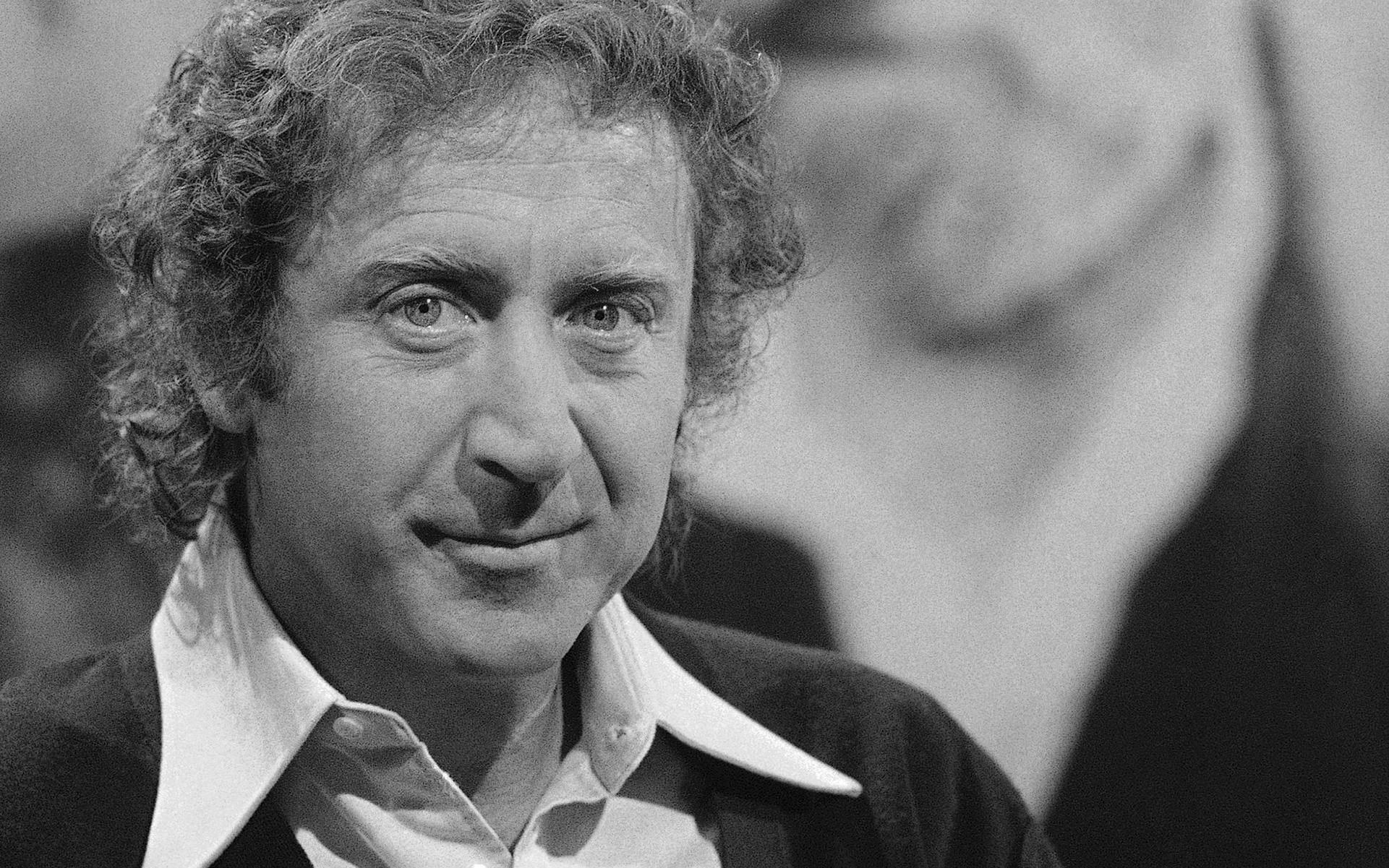If you’ve ever read J.R.R. Tolkien’s The Hobbit or Lord of the Rings or seen Peter Jackson’s film trilogies, you probably recall that Middle Earth’s hobbits are particularly keen on this leaf called “pipe-weed.” It goes by names like Longbottom Leaf, Old Toby, and Southern Star – names that would much later be used by some cannabis breeders for their strains.
Though unsuspecting in the books, Jackson’s portrayal of the hobbits’ herb has given rise to fan theories posing the question, is it really tobacco in their pipes or might something else be growing in the gardens of the Shire?
What is Pipe-Weed?
You don’t need to look further than the book’s appendices to know that Tolkien was talking about tobacco, not cannabis.
“There is another astonishing thing about Hobbits of old that must be mentioned, an astonishing habit: they imbibed or inhaled, through pipes of clay or wood, the smoke of the burning leaves of a herb, which they called pipe-weed or leaf, avariety probably of Nicotiana.”
Did that “probably” leave enough room for the imagination to bring in the possibility of a psychoactive alternative? If you’ve seen Jackson’s movie adaptation, you’d know the answer for many wishful thinkers is yes.

New Line Cinema
In Fellowship of the Ring, Saruman gives Gandalf a judgmental sidelong glance and says, “Your love of the halflings’ leaf has clearly slowed your mind.”
An early scene of Jackson’s Return of the King depicts power couple Merry and Pippin puffing pipes, gorging themselves with food, and grinning with telltale crescent eyes. (Although a scene in the extended edition shows the hobbits popping open a barrel of Longbottom Leaf to reveal tobacco leaves.)
And Jackson’s first installment of The Hobbit shows Radagast the Brown hitting a smoldering pipe with his eyes rolling backward as if to say, “Dang, that was some fire, Gandalf.”
But the subtle stoner-isms found in Jackson’s trilogy are almost definitely a playful deviation from Tolkien’s literary imaginings; it only takes a brief look at who Tolkien was and the historical context in which he wrote to understand why it’s so unlikely.

Warner Bros. Pictures
How Did Tolkien Feel About Cannabis?
J.R.R. Tolkien, born 1892, grew up in England where recreational cannabis consumption was, during this time, almost entirely unheard of. Even its traditional medical uses were becoming “unfashionable,” replaced by newer forms of pain relief like aspirin.
“I am in fact a Hobbit (in all but size)…I smoke a pipe, and like good plain food (unrefrigerated), but detest French cooking.”
When England began its prohibition of narcotics in 1925 (at the Convention of Narcotic Control), consumable cannabis was a product of such insignificance, it was hardly even spoken of until much later. But other countries in the League of Nations – Egypt and Turkey – insisted hashish be prohibited. England followed in suit despite doubts of its enforcement.
Although hemp was a common agricultural product, tobacco was the leaf of choice for those looking to pack a bowl and relax. Tolkien, too, was fond of it. In a 1958 letter to Rayner Unwin, a reviewer of his books, an excited Tolkien described a “Hobbit Dinner” he had been invited to in Holland:
“In this home of ‘smoking’, pipe-weed seems specially to have caught on. There were clay pipes on the table and large jars of tobacco – provided, I believe, by the firm of Van Rossem…In 3 qualities: Longbottom Leaf, Old Toby, and Southern Star. V. Rossem has since sent me pipes and tobacco!”

New Line Cinema
Tolkien’s comparison of himself to hobbits is also telling: “I am in fact a Hobbit (in all but size)…I smoke a pipe, and like good plain food (unrefrigerated), but detest French cooking.” Some also say that tobacco tins were used as storage in his home.
So in summary, it would seem that pipe-weed isn’t at all a euphemism for cannabis, given the historical context in which Tolkien lived. Though it is unfair to say that Tolkien never used cannabis because he was a studious professor, a family man, and a devout Catholic, there exists very few cultural bridges between him and the demographics drawn to cannabis in both Tolkien’s earlier and later life.
Tolkien’s Counter-Culture Following
Coincidentally, the convergence of Tolkien and counterculture groups of the 60s and 70s is precisely where the cannabis connection was to be first forged.
The Hobbit was published in 1937 and Lord of the Rings in 1955, and by time the 60s rolled around, a copy could be found in the hands of college students and young progressives far beyond the borders of England.

New Line Cinema
“In the 1960s [Tolkien] was taken up by many members of the nascent ‘counter-culture’ largely because of his concern with environmental issues,” David Doughan of the Tolkien Society writes in his biography.
With strong overtones of environmental sustainability, anti-industrialism, strong female characters like Arwen and Éowyn, and champion underdogs that stood no more than four feet tall, Tolkien’s books took on a widespread cult following because of their undeniably strong overlaps with civil rights, counterculture, and psychedelic drugs.
“Perplexed by our nation’s carnage in Vietnam and by the ultimate threat of a nuclear inferno, a whole generation of young Americans could lose themselves and their troubles in the intricacies of this triple-decker epic,” writes Ralph C. Wood, a theology and literature professor with an interest in Tolkien. “Indeed, the rumor got about – a wish seeking its fulfillment, no doubt – that Tolkien had composed The Lord of the Rings under the influence of drugs.”
“[Tolkien] could only deplore those whose idea of a great trip was to ingest The Lord of the Rings and LSD simultaneously,” Doughan adds in his biography.

New Line Cinema
But even if his biographies make him sound like a prude, don’t write off the possibility that if Tolkien were a product of another time, he might have in fact preferred cannabis. A hint is left in his book Unfinished Tales, a collection of notes and stories edited and published later by his son Cristopher.
“Both the silence and the smoke seemed greatly to annoy Saruman, and before the Council dispersed he said to Gandalf: ‘When weighty matters are in debate, Mithrandir, I wonder a little that you should play with your toys of fire and smoke, while others are in earnest speech.’
But Gandalf laughed, and replied: ‘You would not wonder, if you used this herb yourself. You might find that smoke blown out cleared your mind of shadows within. Anyway, it gives patience, to listen to error without anger. But it is not one of my toys. It is an art of the Little People away in the West: merry and worthy folk, though not of much account, perhaps, in your high policies.’”
Perhaps Tolkien found mind-clearing qualities in tobacco that many find in cannabis. But regardless of what pipe-weed actually is, or what J.R.R. himself actually smoked, the plants are different means to facilitating same end that no scholar, reader, or critic can deny Tolkien intending: an appreciation toward detail, nature, and things as simple as a pipe full of your favorite herb. And might we suggest one of these LOTR-themed strains?












